
English
1 Your slow juicer
Congratulations on your purchase, and welcome to Philips!
To fully benet from the support that Philips oers, register your product at
www.philips.com/welcome. Read this user manual carefully before you install
and use the unit. Save it for future reference.
2 Important
Read this user manual carefully before you use the appliance, and save it for
future reference.
Danger
• Do not immerse the main unit of the slow
juicer in water, any other uid, nor rinse it
under the tap. Use only a moist cloth to
clean.
Warning
• Check if the voltage indicated on the slow
juicer corresponds to the local power voltage
before you connect it.
• Do not connect the appliance to an external
timer to prevent danger.
• Only connect the slow juicer to a grounded
power outlet. Always make sure that the plug
is inserted rmly into the power outlet.
• Make sure that the damaged power cord
is replaced by Philips, a service center
authorized by Philips or similarly qualied
persons in order to avoid a hazard.
• If you detect cracks in the sieve, the driving
shaft, or any accessories is damaged in any
way, do not use the appliance anymore and
contact the nearest Philips service center. Do
not replace parts of the appliance yourself.
• This appliance shall not be used by children.
• This appliance can be used by persons
with reduced physical, sensory or mental
capabilities or lack of experience and
knowledge if they have been given
supervision or instruction concerning use
of the appliance in a safe way and if they
understand the hazards.
• For their safety, do not allow children to play
with the appliance.
• Keep the appliance and its power cord out of
the reach of children. Do not hang the power
cord over the desk or table edge, where you
place the appliance.
• To prevent a short circuit or an electric shock,
make sure that your hands are dry before
you insert the plug into the power outlet and
switch on the appliance.
• Never let the appliance run unattended.
• Never reach into the feeding tube and the
main unit with your ngers or an object
while the slow juicer is running. Never use
any objects to replace the pusher. Keep
your eyes from the feeding tube to avoid
accidents.
Caution
• This appliance is intended for household use
only.
• Never use any accessories or parts from
other manufacturers or that Philips does
not specically recommend. If you use
such accessories or parts, your guarantee
becomes invalid.
• Do not use this appliance on an unstable or
uneven surface.
• Before you insert the plug into the power
outlet, make sure that the appliance is
assembled correctly.
• Unplug the appliance immediately after use.
• Switch o and unplug the appliance from the
power outlet after use. Wait till the main unit
and the driving shaft stop turning, then you
can take out any accessories from the main
unit.
• Cut large ingredients into pieces that t into
the feeding tube. Remove stones, cores,
seeds, and thick peels in fruits or vegetables
before juicing.
• Do not exert too much pressure on the
pusher, since this would aect the quality of
the end result and it could even cause the
driving shaft to come to a halt.
• Food coloring can discolor components. This
is normal and has no impact on use.
• Do not use the appliance continuously for
more than 30 minutes. This is to protect the
lifetime of the appliance.
• When the appliance is stopped and cannot
automatically reverse, turn the control knob
to OFF. Then, turn the control knob to the
REV position to clear the ingredients from the
appliance. Turn the control knob to ON again
to use the appliance. If it is still blocked,
clean the driving shaft before you re-use
again. This is to protect the appliance.
• To prevent damages due to heat
deformation, never use water with a
temperature of over 60°C or a microwave
oven to clean all components.
• Do not use scouring pads, abrasive cleaning
agents or aggressive liquids such as petrol,
alcohol or acetone to clean the appliance.
EMF
This Philips appliance complies with all applicable standards and regulations
regarding exposure to electromagnetic elds.
3 Overview (fig. 1)
a
Driving shaft
g
Backup sealing ring
b
Fine sieve
h
Cleaning brush
c
Coarse sieve (HR1882 only)
i
Main unit
d
Juice collector
A. Pulp spout
B. Juice spout
C. Drip-proof plug
D. Sealing ring
j
Control knob
e
Pulp container
k
Lid
E. Feeding tube
F. Tray
f
Juice jug
l
Pusher
4 Before first use
Take out all the accessories and clean the parts of the slow juicer thoroughly
before using it for the rst time (see chapter “Cleaning”).
Make sure all parts are completely dry before you start using the slow juicer.
5 Assembling the slow juicer (fig. 2)
Note
• Make sure the sealing ring is rmly inserted into the juice collector.
• If the sealing ring on the juice collector is aging or damaged, replace it with the
backup sealing ring.
1 There is a rubber pad underneath the juice collector. Before using the
appliance, make sure it is rmly plugged in to avoid leakage or prevent
the pulp outlet from getting blocked.
2 Align the indications on the sieve ( ) and the one on the juice collector,
and then put the sieve into the juice collector.
3 Place the driving shaft into the sieve.
4 Place the lid onto the juice collector. Turn the lid clockwise until the
indication ( ) on the juice collector and on the lid are aligned.
5 Align the indications ( , ) on the juice collector and the main unit
respectively. Then, insert the juice collector into the main unit.
6 Put the pulp container and juice jug under the spouts respectively.
6 Using the slow juicer (fig. 3)
Caution
• Never insert your ngers or an object into the feeding tube.
• When the appliance is stopped and cannot automatically reverse, turn the control
knob to the o position “O”. Then, turn the control knob to the reverse position
“
” to clear the ingredients from the appliance. Turn the control knob to “I” again
to use the appliance. If it is still blocked, clean the driving shaft and remove food
residues in it before you re-use again. This is to protect the appliance.
Note
• The appliance will only function if all parts have been properly assembled and the
lid has been properly locked in place with the juice collector.
• Cut the ingredients into pieces that t into the feeding tube.
• For HR1882, the coarse sieve is more suitable to juice soft fruits or vegetables such
as tomatoes and berries.
• During processing, the appliance may vibrate slightly. This is normal.
• Do not exert too much pressure on the pusher, as this could aect the quality of the
end result and it could even cause the sieve to come to a halt.
• To prevent juice from dripping onto the table, insert the drip-proof plug into the juice
outlet before moving the juice jug from under the juice outlet.
• Drink the juice immediately after you have extracted it. If it is exposed to air for some
time, the juice loses its taste and nutritional value.
Tip
• Use fresh fruit and vegetables, as they contain more juice. Fruits like apples, pears,
pineapples, grapes, pomegranates, oranges and melons, and vegetables like carrots,
cucumbers, tomatoes, celery stalks are suitable for processing in the slow juicer.
• When juicing a large amount of hard fruits or vegetables such as carrots, celery
stalks and spinach, the rubber pad on the juice collector might be pushed open,
and the appliance might be blocked. To help avoid the situation, cut the fruits or
vegetables into small cubes or pieces.
• Remove thick peels, e.g. those of pineapples, oranges and pomegranates. You do
not have to remove thin peels or skins.
• If you want to juice fruits with stones, such as peach, plum or cherry, remove the
stone before juicing.
• The slow juicer is not suitable for processing very hard and/or brous or starchy
fruits or vegetables such as sugar cane. Fruits that contain starch, such as bananas,
papayas, avocados, gs and mangoes are also not suitable for processing in the
slow juicer. Use a food processor or blender to process these fruits.
7 Cleaning (fig. 4)
Cautions
• Before cleaning, make sure the appliance is switched o and the sieve has stopped
rotating.
• Never use scouring pads, abrasive cleaning agents or aggressive liquids such as
alcohol, petrol or acetone to clean the appliance.
• Never immerse the motor unit in water nor rinse it under the tap.
• Do not clean the sieve with your hands to avoid getting cut. Use the provided brush
for this matter.
Note
• Apart from the main unit, lid, pusher, and the brush, all the other parts are
dishwasher proof.
• Wipe the appliance with a soft cloth and make sure the appliance is clean and dry
before storage.
Tip
• The appliance is easier to clean if you do so immediately after use.
• Use the pointed top of the cleaning brush to poke out the pulp stuck in the
detachable parts.
1 Take out the pusher.
2 Turn the lid anti-clockwise until aligns with the indication ( ) on the
juice collector, and then remove the lid.
3 Remove the juice collector from the main unit.
4 Take out the driving shaft, sieve and sealing ring.
5 Unplug the rubber pad underneath the juice collector, and use the point
top of the cleaning brush to poke out food residues inside of the pulp
outlet.
6 Use the silicone end of the cleaning brush to wipe o the pulp on the
sieve, and then brush away the pulp stuck in the holes.
7 Clean the detachable parts with the provided cleaning brush in warm
water with some washing-up liquid and rinse them under the tap.
8 Clean the main unit with a damp cloth.
8 Recycling
This symbol means that this product shall not be disposed of with
normal household waste (2012/19/EU).
Follow your country’s rules for the separate collection of electrical
and electronic products. Correct disposal helps prevent negative
consequences for the environment and human health.
9 Guarantee and service
If you have a problem, need service or need information, see
www.philips.com/support or contact the Philips Consumer Care Center in your
country.
HR1880
HR1882
Specifications are subject to change without notice
© 2016 Koninklijke Philips N.V.
All rights reserved.
4241 210 18294
a
b
c
d
A
C
D
e
f
l
E
F
k
j
i
B
g
4
1
3
5
2
4
2
3
4
3
4
5
7
6
8 9
1
3
2
1
2
3
1
3
10
2
1
2
1
11
h
Register your product and get support at
www.philips.com/welcome
Question?
Contact
Philips
Always there to help you
NL Gebruiksaanwijzing
NO Brukerhåndbok
PL Instrukcja obsługi
PT Manual do utilizador
SV Användarhandbok
EN User manual
DA Brugervejledning
ES Manual del usuario
FI Käyttöopas
FR Mode d’emploi
IT Manuale utente
1/3


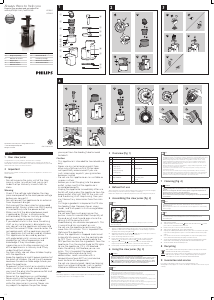

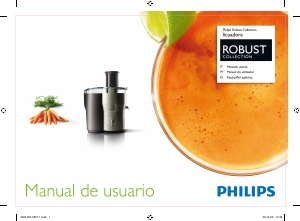
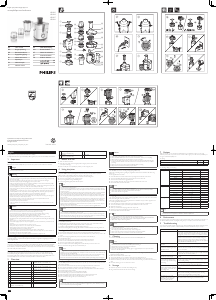
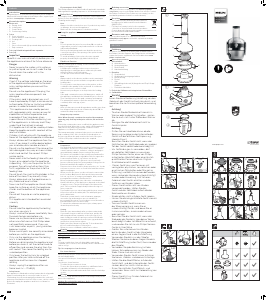
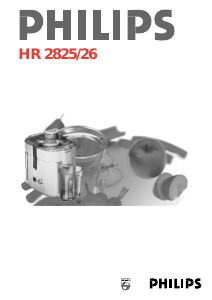
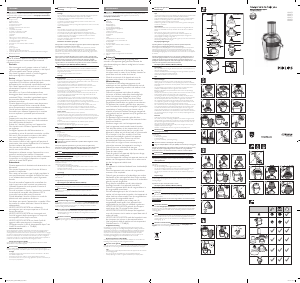
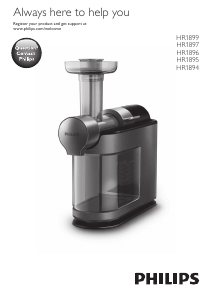
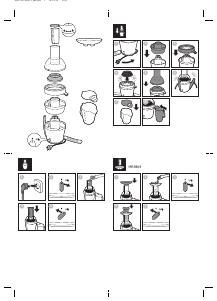
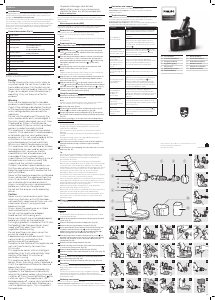
Partecipa alla conversazione su questo prodotto
Qui puoi condividere cosa pensi di Philips HR1880 Centrifuga. Se hai una domanda, leggi prima attentamente il manuale. La richiesta di un manuale può essere effettuata utilizzando il nostro modulo di contatto.